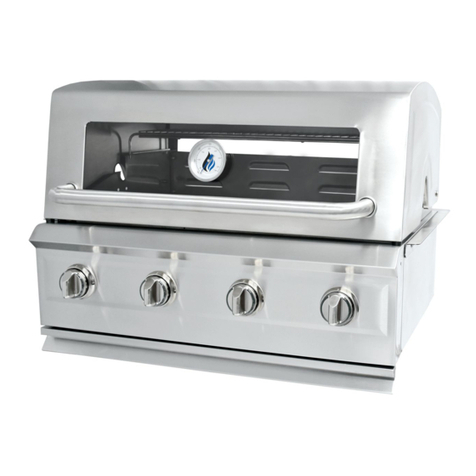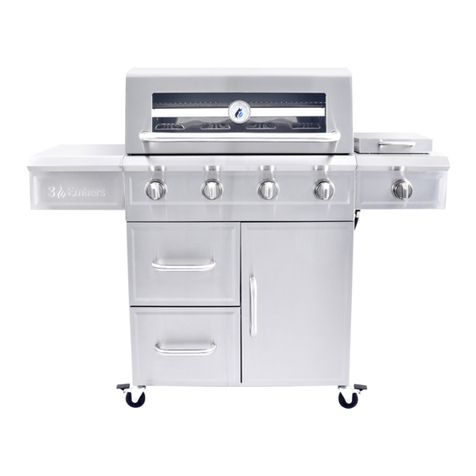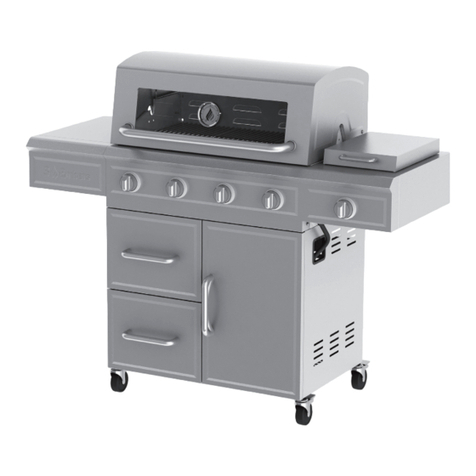
3
WARNING
• Leak test all connections before rst use, even if grill was purchased fully assembled and after each
tank rell. Check propane tank rubber seal for damage.
• Always check grill and propane tank prior to each use as indicated in “Checking for Leaks” & “Pre-
Start Check List” sections of this manual.
• Never use natural gas in a unit designed for liquid propane gas.
• Flavoring chips must be contained in a metal smoking box to contain ash and prevent res.
• Ensure ames come out of all burner ports at each use. Spiders and insects like to build nests in
burner tubes. Blocked burner tubes can prevent gas ow to burners and could result in a burner tube
re or re beneath grill.
• Never check for leaks using a match or open ame.
• Never use or store gasoline, lighter uid, paint thinner, or other ammable vapors and liquids or
combustible materials in or near your grill.
• DO NOT block ventilation areas in sides, back or cart compartment of grill.
• DO NOT cover cooking grates or other components with aluminum foil, as this blocks ventilation and
damage to grill or personal injury may occur.
• Never place more than 15 pounds on side tables. DO NOT lean on side tables. DO NOT lift grill using
side tables.
• Keep children and pets away from hot grill. DO NOT allow children to use or play near this grill.
• DO NOT leave grill unattended while ON or in use.
• DO NOT allow gas hose to come in contact with hot surfaces. Redirect gas hose if necessary.
• DO NOT allow grease or hot drippings to fall on hose and regulator assembly. If this occurs, turn gas
supply OFF at once. Empty grease tray/cup and clean hose and regulator assembly and inspect for
damage before use.
• Never cook on grill without grease cup/tray in position.
• DO NOT use water on a grease re. Closing lid to extinguish a grease re is not possible. Use type
BC dry chemical re extinguisher or smother with dirt, sand or baking soda.
• DO NOT use while under inuence of drugs or alcohol.
• FOR OUTDOOR USE ONLY. DO NOT operate indoors or in an enclosed area such as a building,
garage, shed or breezeway.
• Position your grill outdoors on a non-combustible level surface in a well ventilated location, a safe
distance 10 ft. (3.1 m) from combustible materials, buildings and overhangs.
• Apartment dwellers: Check with management and follow requirements and re codes for using a
LP gas grill in your apartment complex. Only use outside on ground (not on a balcony, patio, garage,
etc) with a 15 foot (4.6 m) minimum clearance on back and all sides from any wall, structure or
combustible material.
• Maintain a minimum clearance of 36 inches (91 cm) between back and all sides of grill, deck railings,
walls or other combustible material. Not adhering to these clearances may prevent proper ventilation
and can increase risk of a re and/or property damage, which could also result in personal injury. DO
NOT use grill under overhead combustible construction.
• DO NOT use or install this grill in or on a recreational vehicle and/or boat.
• DO NOT build this model grill in any built-in or slide in construction.
• If a bristle brush is used to clean any cooking surfaces, ensure no loose bristles remain on cooking
surfaces prior to grilling as loose bristles may attach to food.
• DO NOT store items in cart that can catch re or damage your grill (such as swimming pool supplies/
chemicals, table cloth, wood chips).
GENERAL WARNINGS:

































